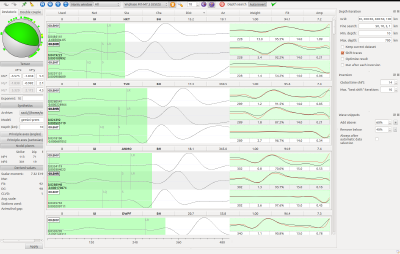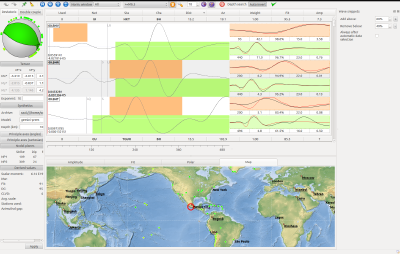Moment Tensors
Compute and analyze moment tensors
Overview
Introduction
The focal mechanism of an earthquake describes the inelastic deformation in the source region that generates the seismic waves. In the case of a fault-related event it refers to the orientation of the fault plane that slipped and the slip vector and is also known as a fault-plane solution. Focal mechanisms are derived from a solution of the moment tensor for the earthquake which itself is estimated by an analysis of observed seismic waveforms.
The moment tensor solution is typically displayed graphically using a so-called beachball diagram. The pattern of energy radiated during an earthquake with a single direction of motion on a single fault plane may be modeled as a double couple which is described mathematically as a special case of a second order tensor (similar to those for stress and strain) known as the moment tensor .
Our moment tensor inversion technique uses a combination of several seismic wave types, time windows and frequency bands carefully chosen based on event magnitude and station distance. Wave types include body waves, surface waves, mantle waves as well as the so-called ‘W-Phase’ (Kanamori and Rivera, 2008).
The inversion is performed in the time domain only. An iterative centroid search can be performed independently both horizontally and in depth.
Moment tensors can be computed in an automatic fashion within a few seconds of waveform data becoming available. Prior to publication, solutions can be reviewed by an analyst using the graphical user interfaces.
Applications
- Local, national and regional networks,
- Tsunami early warning,
- Fast determination of moment magnitude and focal mechanism.
Features
- Rapid moment tensor inversion in the time domain,
- Real-time module fully integrated into SeisComP,
- Real-time restitution for maximum speed,
- Fits body waves, surface waves, mantle waves and W-phases,
- Configurable profiles for magnitude ranges,
- Interactive analysis,
- Statistical tests of solution stability,
- Moment-tensor decomposition.
Method
The core of our method is based on a seismic moment tensor inversion using the three-component full waveforms and a set of precomputed Green’s functions with 8 or 10 components (ZSS, ZDS, ZDD, RSS, RDS, RDD, TSS, TDS[, REP, ZEP]) in the time domain following the approach of Dreger (2003) as described in the International Handbook of Earthquake and Engineering Seismology.
Before the actual inversion takes place, the algorithm automatically corrects the data for instrument response, removes the mean and linear trends and checks for unclipped data and a configurable minimum acceptable signal-to-noise ratio. Furthermore the data are downsampled to the sampling rate of the Green’s functions used. A goodness-of-fit (GOF) is computed describing how well the observed data are represented by the computed moment tensor with respect to the Green’s functions.
Modules

scmtv is used to create and revise moment tensor solutions.

Map plot of the waveform review page. It shows the all contributing stations.
scautomt runs in real-time and computes moment tensor solutions in near real-time fully automatically triggered by events created by a SeisComP system.
It is configured with a set of magnitude dependent profiles. Each profile defines the phases to invert for and the corner periods of the band pass filter.
When triggered by an event, solutions for all profiles matching the SeisComP magnitude estimate are used and the solution with the highest fit (or lowest misfit) is sent back to the SeisComP system as as focal mechanism object which is in turn considered by scevent to be selected as preferred solution.
Once an event is received by scautomt, it starts to read waveforms of all enabled stations up to a configurable epicentral distance (preferably via SeedLink or any other streaming server) and updates the solution if there is a significant amount of new data.
scmtv (Moment Tensor View) is the counterpart to scolv to review automatic or manual moment tensor solutions.
It allows operators to check observed and synthetic waveforms, add and remove networks, stations, components or even single waveform snippets. scmtv supports an automatic best fit search or allows interaction at all analysis levels.
Predefined profiles allow an easy switch between different filter settings as for example settings for body- and surface wave or W-phase analysis for different magnitude classifications. Colors indicate the different wave types.
An automatic depth search can be conducted and the results are visualized in the depth search plot. In addition, scmtv provides several tools and plots to check the quality and stability of the solution.
Promotion
Approved by science
scmtv and scautomtv have been operational in real time at many data centers world wide. The results have been used, demonstrated, promoted and discussed with scientists and the SeisComP community in scientific publications and at international science conferences, e.g.:
- W. Hanka, J. Saul, B. Weber, J. Becker, P. Harjadi, Fauzi, and GITEWS Seismology Group: Real-time earthquake monitoring for tsunami warning in the Indian Ocean and beyond, 2010, Nat. Haz. Earth Sys. Sci., 10 (2611-2622), doi: 10.5194/nhess-10-2611-2010
- J. Saul, J. Becker, W. Hanka: Global moment tensor computation at GFZ Potsdam, 2011. AGU Fall Meeting, San Francisco, USA, abstract ID. S51A-2202
- D. Roessler, S. Al-Harthy, B. Weber, B. Alrumhi, and the team of gempa: Monitoring of earthquakes and tsunamis at the National Tsunami Warning Center of DGMET, Oman, 2018, 10th Gulf Seismic Forum, Muscat, Oman
